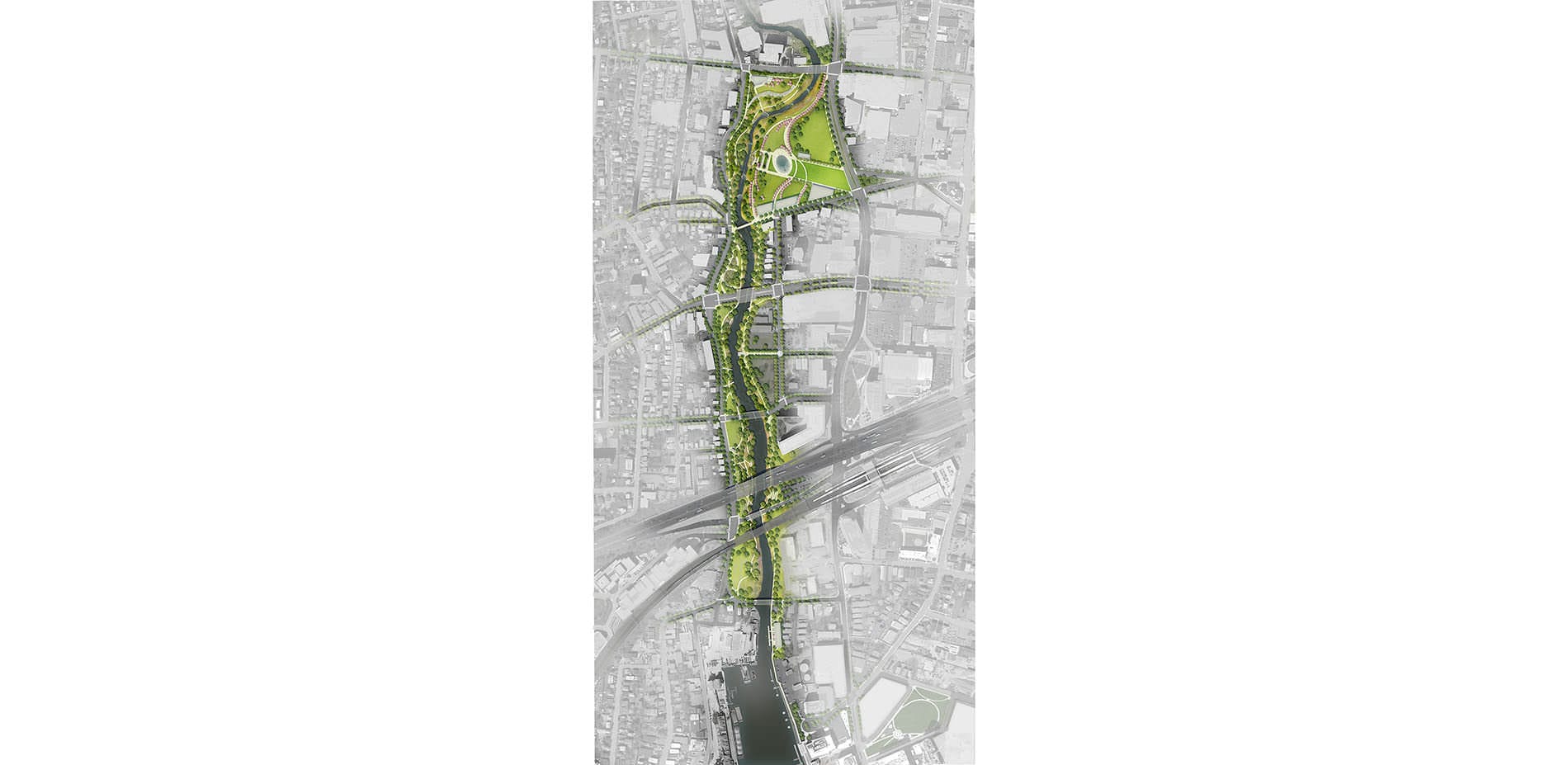
ILLUSTRATIVE SITE PLAN - Formerly a polluted and channelized riverfront, Mill River Park is now a vibrant and verdant community space in downtown Stamford, Connecticut. Working closely with engineers and ecologists, the design team rebuilt the river and revitalized aquatic and terrestrial habitats.
Photo Credit: © OLIN
Media: Please submit high-resolution image requests to images@asla.org.
MILL RIVER PARK AND GREENWAY - The site of a former millpond has been replaced by the rebuilt and gracefully meandering Mill River paralleled by sinuous paths. A native vegetation palette follows the contours rising up the embankments from hydric to mesic to urban upland.
Photo Credit: © OLIN / Sahar Coston-Hardy
Media: Please submit high-resolution image requests to images@asla.org.
MILL RIVER PARK AND GREENWAY - Once the mill was abandoned, the remnant walls–built in 1922–severed the city and residents from the river. With increased urbanization, the channelized river became the source of major flooding throughout the downtown.
Photo Credit: Courtesy of Mill River Collaborative
Media: Please submit high-resolution image requests to images@asla.org.
MILL RIVER PARK AND GREENWAY - Today that has all changed. Paved paths lead to informal stone walkways that become gravel banks inviting access to the river’s edge.
Photo Credit: © Olivier Kpognon
Media: Please submit high-resolution image requests to images@asla.org.
MILL RIVER PARK AND GREENWAY - In 2000, The Army Corps of Engineers developed a proposal to naturalize the river corridor with a new understanding that restoring the river’s edge would prevent flooding due to urbanization. This included the removal of all obstructions and impoundments.
Photo Credit: Sue Sweeney
Media: Please submit high-resolution image requests to images@asla.org.
MILL RIVER PARK AND GREENWAY - The restoration allowed Mill River to flow freely for the first time since the 1600s. The river is now pristine as it flows through downtown Stamford on its way to Long Island Sound.
Photo Credit: © Olivier Kpognon
Media: Please submit high-resolution image requests to images@asla.org.
MILL RIVER PARK AND GREENWAY - After copious spring rains, the river flows high on its banks but poses no risk of flooding to the surrounding city.
Photo Credit: © KJ Klopstock
Media: Please submit high-resolution image requests to images@asla.org.
MILL RIVER PARK AND GREENWAY - Planting blends the needs of a natural riparian corridor with the demands of an urban park. Diversity and sustainable ecosystems are balanced with urbanity. Vegetation is used to provide habitat, maintain visibility, and provide a spatially rich and maintainable park.
Photo Credit: © OLIN / Sahar Coston-Hardy
Media: Please submit high-resolution image requests to images@asla.org.
MILL RIVER PARK AND GREENWAY - Sinuous paths parallel the river and allocate space for walking, jogging, and bicycling as well as providing opportunities for resting and viewing.
Photo Credit: © OLIN / Sahar Coston-Hardy
Media: Please submit high-resolution image requests to images@asla.org.
MILL RIVER PARK AND GREENWAY - Residents reunite with the waterfront and are offered respite from the commotion of a city only steps away. The hum of the street succumbs to chirping birds, noisy insects and rippling water.
Photo Credit: © OLIN / Sahar Coston-Hardy
Media: Please submit high-resolution image requests to images@asla.org.
MILL RIVER PARK AND GREENWAY - The native plants, including grasses, wildflowers, shrubs, understory trees and canopy trees, were carefully coordinated to revitalize degraded aquatic and terrestrial habitats.
Photo Credit: © OLIN / Sahar Coston-Hardy
Media: Please submit high-resolution image requests to images@asla.org.
MILL RIVER PARK AND GREENWAY - Along the steps in front of the “Great Lawn” people overlook the river and gather for movie nights and other events during the summer.
Photo Credit: © OLIN / Will Belcher
Media: Please submit high-resolution image requests to images@asla.org.
MILL RIVER PARK AND GREENWAY - Caledonia granite paving adjacent to the “Great Lawn” and stepping down toward the river provides space for a variety of programmed activities.
Photo Credit: © Olivier Kpognon
Media: Please submit high-resolution image requests to images@asla.org.
MILL RIVER PARK AND GREENWAY - The community has whole-heartedly embraced its new park. Here children are on their way to a Halloween celebration in the park.
Photo Credit: © Olivier Kpognon
Media: Please submit high-resolution image requests to images@asla.org.
MILL RIVER PARK AND GREENWAY Careful placement of rocks create veins, riffles, falls, and pools. Each element has a function: slowing water flow, accommodating grade change, and creating still areas for spawning fish and amphibians. These hardworking features also double as an active learning playground.
Photo Credit: © OLIN / Will Belcher
Media: Please submit high-resolution image requests to images@asla.org.
MILL RIVER PARK AND GREENWAY - The design led to a significant drop in pollution and debris resulting in an immediate influx of indigenous wildlife. The mallard, river otter and ground nesting birds are just some of the animal species now integrated into this diverse urban setting.
Photo Credit: © OLIN / Sahar Coston-Hardy
Media: Please submit high-resolution image requests to images@asla.org.



















